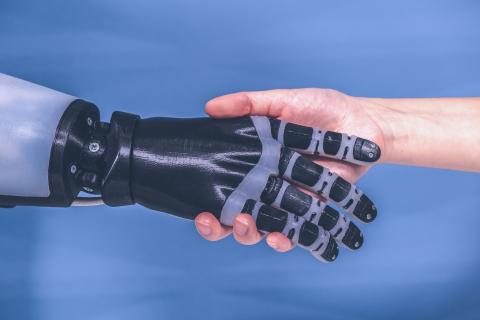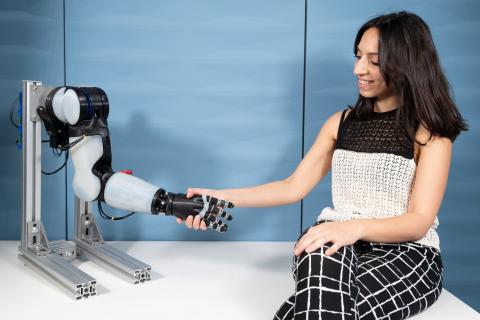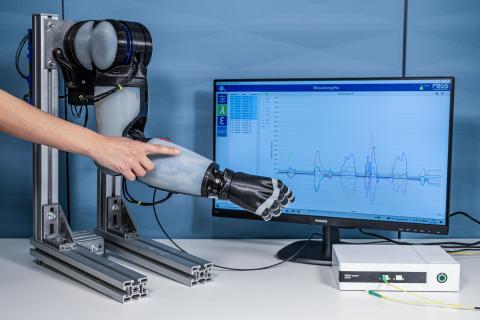Collaborative Robotics: fiber optic tactile sensors and artificial intelligence for the development of a new sensorized artificial skin: "It's a key enagling technology for safe interaction between robots and humans"
To enable the safe physical interaction of machines with environment and people, we can now integrate a new sensorized artificial skin on collaborative robots. A study coordinated by The BioRobotics Institute of Sant'Anna School, in collaboration with the Italian Institute of Technology, Sapienza University of Rome, Campus Bio-Medico University of Rome and Ca' Foscari University of Venice, and the ARTES 4.0 competence center, published in the international scientific journal Nature Machine Intelligence, presented the development of an innovative artificial skin that emulates a family of human skin corpuscles, the receptors called Ruffini corpuscles.
"With this groundbreaking artificial touch technology," says Calogero Oddo, associate professor at the BioRobotics Institute at Sant'Anna School and scientific coordinator of the study, "we have shown the ability to encode, over a large area with complex geometry, two fundamental properties of human tactile perception: the location of the contact point and the intensity of the force with which the robot interacts with the environment."
Photonic sensors and integration of physical and artificial intelligence
"The biomimetic skin we made," illustrates Mariangela Filosa, a PhD student at the BioRobotics Institute at Sant'Anna School and co-author of the study, "consists of a soft polymer matrix that integrates photonic Bragg grating sensors."
According to Edoardo Sinibaldi, a researcher at the Italian Institute of Technology who scientifically co-supervised the study: "The results were fostered by a suitable integration between physical and artificial intelligence. Sensor positioning in the artificial skin, indeed, was defined based on physical intelligence (sensors must be placed at a certain distance and depth, in order to "talk to one another" through the skin), while artificial intelligence was used to interpret sensors readout. Moreover, complementary numerical techniques were exploited, such as the multigrid approach commonly used in computational fluid dynamics, to refine the output of the artificial intelligence algorithms, thus remarking the potential to effectively advance the addressed research field through a multidisciplinary approach".
A collaboration between italian excellence in research and innovation
The technology was developed at the BioRobotics Institute of the Sant'Anna School thanks to a scientific interaction of the Neuro-Robotic Touch Lab, coordinated by Calogero Oddo, with Edoardo Sinibaldi of the Italian Institute of Technology, Eduardo Palermo, a researcher at the Sapienza University of Rome, Emiliano Schena, a professor at the Campus Bio-medico University of Rome, with Ca' Foscari University Venice, and with the ARTES 4.0 competence center.
LINK: https://doi.org/10.1038/s42256-022-00487-3
Authors:
Luca Massari*, Giulia Fransvea*, Jessica D’Abbraccio, Mariangela Filosa, Giuseppe Terruso, Andrea Aliperta, Giacomo D’Alesio, Martina Zaltieri, Emiliano Schena, Eduardo Palermo, Edoardo Sinibaldi, Calogero Maria Oddo.
Functional mimicry of Ruffini receptors with fibre Bragg gratings and deep neural networks enables a bio-inspired large-area tactile-sensitive skin.
Nature Machine Intelligence, 2022.
* These authors contributed equally: Luca Massari, Giulia Fransvea






